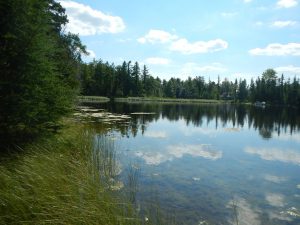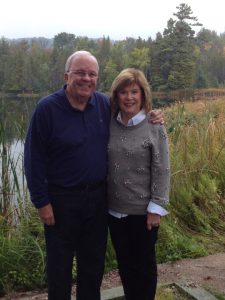
Jim and Beverly Duff have six grandchildren between the ages of 8 and 13. One of the things they all like to do when the kids visit is to take their electric pontoon boat onto Brooks Lake. This tiny lake is located just a stone’s throw from the Duff’s beautiful home on the shores of Big Glen—and lies literally at the edge of their back yard.
“I love being back there,” says Jim. “Sometimes we get out on the water, turn off the motor and just sit. Pretty soon the animals forget about us and they come out to play. A family of otters playing near a downed tree in the lake, five herons setting their wings and landing right in front of the boat, and a huge snapping turtle that seems to like checking the boat out are just a few of the creatures we’ve seen from the pontoon.”
“Jim just loves that land and has nurtured it for years,” says Beverly. “Every spring when we come back he just walks around the property as if he is seeing it for the very first time.”
Jim is originally from Kansas and spent the summers during his college years working for the U.S. Forest Service in Idaho. He lived on Priest Lake, a beautiful mountain lake in the Kaniksu National Forest in the Idaho panhandle. He got hooked on woods and water and all things related. When he later started his career in finance at Ford Motor Co., he asked his new boss (who was from Utah and knew Priest Lake) where he could find a lake similar to Priest Lake in Michigan. Well, we don’t have mountains in Michigan but in my mind Glen Lake is our most beautiful lake, his boss said. Jim checked it out, immediately fell in love, and he and his family proceeded to vacation there every summer. They rented for a number of summers and in 1974 bought the parcel on Brooks Lake that includes almost all of the land included in the Conservation Easement.
The ecologically rich Brooks Lake portion of the property is now forever protected. The Duffs have donated a conservation easement on nine of their 24 acres. Director of Land Programs, Matt Heiman, first visited the property in the spring of 2012. “I was blown away by how much water was pouring out of the ground,” says Matt. “And as an avid fisherman, I was also pretty excited to see that the whole end of Brooks Lake along the conservation easement fills up with minnows when they come in to spawn in the springtime.”

Normally, says Matt, the Conservancy doesn’t take on projects as small as nine acres. Jim laughs when he recalls Matt’s first visit. “I think he came at the request of Brian, thinking why is he asking me to look at a 9-acre parcel? When he returned from touring the property, however, I saw a big change in his interest. I frankly didn’t know that the Conservancy didn’t do small easements. I just knew that that the parcel was the only way to protect what remains of the Brooks Lake watershed.”
Matt agrees, calling the land “one of the most ecologically dense parcels I have ever seen in Leelanau County.” Three distinct groundwater fed streams emerge from the Duff’s wetlands and flow into Brooks Lake, which connects to Glen Lake. “These nine acres are very important to maintaining the water quality of Big Glen and its fishery,” adds Matt.
Protecting his land was a decision that Jim struggled with. “I’m a person who likes to keep his options open and frankly I was torn about it,” he says. “I knew I was caring for the land and that nothing was going to happen to it as long as I did so, but I also knew that I couldn’t be sure that somewhere down the road someone wouldn’t damage the wetlands. Even though the law protects them, there’s only so much policing that the DEQ can do. Thus, I embraced the formality of a conservation easement. It puts people on notice that the land is protected, defines what can and can not be done to the property, and it’s monitored and enforced. Perhaps more importantly, it does all this forever.”
The terms of the Duff’s easement allow them to maintain a driveway corridor that runs through it. “The Conservancy was willing to include terms that addressed my concerns about maintaining the driveway to our house. Thus, I’m happy with the terms we agreed to,” says Jim. “They include what the Conversancy needs to protect the watershed and it lets us maintain the drive to our house. I think that more needs to be done around Glen Lake to ensure its protection. Being labeled “the most beautiful place in America” is adding to the human pressures on both the land and the lakes. I hope that our action will encourage Glen Lake property owners to consider creative ways to formally protect this most important asset. It certainly has encouraged us to see what more we can do.”
Why protect wetlands?
Michigan’s wetland protection laws provide important safeguards against reckless development and conversion of wetland areas to other land uses. However, it is important to note that these laws do not necessarily protect the ecological integrity of these wetland habitats. Under Michigan Law, it is legal for the landowner to cut down and remove any tree or vegetation they so choose, provided that the roots and soils are left intact. Maintaining healthy and diverse wetland vegetation, particularly along streams and inland lakes shores, is very important for wildlife habitat and water quality protection. This is why the Conservancy encourages wetland landowners to consider permanent land protection options even though there is typically no development potential for that part of their property.



